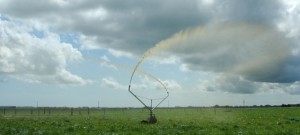I spent a day with staff from a regional council discussing farm dairy effluent application. In particular, they were interested in protocols for monitoring the performance of travelling irrigators. They need efficient and acceptable ways to monitor compliance with regional plan rules and resource consent conditions.
It is an interesting topic.
For the purpose of effluent application, the regional council has defined high and low risk soils, and different consent conditions apply. And of course, there are variations on conditions depending on when consents were issued, the location of the site and so on. And some consent conditions apply to nutrient loadings, including both 24 hour and annual time frames. Yet others relate to soil moisture status, and others to applied depths.
We discussed a lot of things:
- soil water physics; including application depths, rates, and uniformity
- surface ponding and over-land flow or run-off
- the Farm Dairy Effluent System Design Code of Practice and Design Standards,
- the Irrigation Evaluation Code of Practice,
- current approaches for assessing dairy effluent irrigators
- results from system evaluations
- accuracy and confidence of monitoring results
Then we went out to a farm and physically measured travelling effluent irrigator performance. And we debriefed.
And so to a protocol: what elements are required?
A protocol needs to be:
- recognised – look for existing procedures and processes that are suitable
- defensible – ensure sufficient sampling and fair statistics
- cost-effective – be efficient, not overly time consuming
- meaningful – so everyone can understand the process and the outcomes
Most, if not all, of these are available. The Irrigation Evaluation Code of Practice and the Farm Dairy Effluent System Design Code of Practice and Design Standards, cover field sampling, statistics and standards reasonably well.
But they were not developed as tools to audit performance of Farm Dairy Effluent irrigation performance (equipment and management) against the full range of regional plan rules and individual resource consent conditions that are found within one region, let alone across the country.
And as a country, we still have not agreed on how to assess surface ponding, or interpret our findings. What is acceptable in what environments, and over what time frames?

